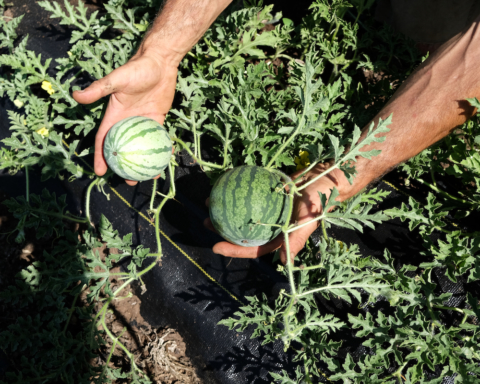Marjorie Harris BSc, IOIA V.O.
CAN/GSB-32.310-2015: Amended March 2018
5.4.1 The main objective of the soil fertility and crop nutrient management program shall be to establish and maintain a fertile soil using practices that maintain or increase soil humus levels, that promote an optimum balance and supply of nutrients, and that stimulate biological activity within the soil.
We are in the Anthropocene Epoch.
Although the term Anthropocene Epoch, or the Human Epoch, has not yet received official approval as a recognized subdivision of geological time, in common jargon it refers to a new time epoch where human activities significantly impact and shift Earth’s geology and ecosystems. This includes climate changes due to the advent of agriculture, deforestation, and earthworm expansion, resulting in the increased release of carbon dioxide and greenhouse gases into the atmosphere.
Small but Mighty
In addition to agriculture contributing to deforestation, it also promoted the dominance and spread of earthworm populations. A study in the journal Nature Climate Change reports that earthworms are small but mighty in their impact on the climate. A meta-analysis of previous studies suggests the worms may actually increase soil outputs of two key greenhouse gases, carbon dioxide and nitrous oxide. The study found that the presence of earthworms appears to increase soil outputs of CO2 by 33 percent and of nitrous oxide by 42 percent, demonstrating the essential role worms exert in determining the greenhouse gas balances of soils globally. Although earthworms are largely beneficial to soil fertility, they do increase net soil greenhouse gas emissions and that influence is expected to increase in the decades to come.
Decent into Glaciation Triggered by Earth’s Orbital Variations
Milutin Milankovitch, a Serbian Mathematics professor, theorized and then proved that Earth’s periodic glaciations are triggered by variations in Earth’s orbit. Milankovitch calculated the cyclical changes in climate based only on Earth’s orbital variation in relationship to the Sun caused by the additive effects of Orbital Eccentricity (100,000 year cycle), Axial Tilt (41,000 year cycle), and Precession (23,000 year cycle). The results demonstrated that over the last million years the climate has been varying between long glacial periods and short warming periods creating a cyclical 25% temperature variation at 65o North over the 100,000 year Milankovitch cycle.
A leading expert in Climate Change, Dr. Dan Britt, Pegasus Professor of Astronomy and Planetary Sciences at the Department of Physics, University of Central Florida, has graphed out (Figure 1) the temperature divergence attributed to the beginning of the Anthropocene Epoch, starting 10,000+ years ago with the advent of agriculture, deforestation, and earthworm expansion and leading up to the 20th century with fossil fuel consumption. The graph in Figure 1 shows the Milanovitch prediction for a cooling trend heading toward a glaciation period. The diverging lines indicate the actual temperatures (trending upwards) versus the prediction (trending downwards). Dr. Britt spent part of his scientific career studying ancient ice cores to determine temperature conditions and can attest to the results he presents in his lectures and publications.
The Plant Health Pyramid
Fortunately, while agriculture, deforestation, and earthworms were releasing the first 50 percent of the atmosphere’s greenhouse gases, farmers and scientists were making advances in understanding the promoters of plant, soil, and ecosystem health.
An example of a leading advancer of plant and soil health is John Kempf and his Plant Health Pyramid method of crop production. John started the “Advancing Eco Agriculture” website as a platform to share plant health knowledge and it is worth checking out (https://www.advancingecoag.com/). Kempf based his plant health approach on ideas put forward in a book written by Francis Chaboussou, Healthy Crops: A New Agricultural Revolution, published in 2005. Chaboussou proposes a theory of plant health that he calls ‘Trophobiosis’. The foundation concept is that insects and diseases are unable to use food sources comprised of complete proteins and carbohydrates.
According to John Kempf, “the degree of plant health and immunity is based on a plant’s ability to form structurally complete compounds such as carbohydrates and proteins. Complete carbohydrates, proteins, and lipids are formed by healthy plants with a fully functional enzyme system, which is dependent on trace mineral enzyme cofactors.” In order for plants to form complete compounds they need certain micronutrients along with environmental factors.

Here is a thumbnail sketch description of John Kempf’s Plant Health Pyramid (also see Figure 2):
Phase #1: Complete Photosynthesis
Complete photosynthesis is the foundation of plant health and growth. As the plant harnesses the sun’s energy into sugars, the first sugars to form are simple monosaccharides. As the plant secures more resources they can produce complex sugars such as cellulose, pectin, and starches, and the plants become more resistant to soil born pathogens. John’s experience shows that soil pathogens decrease as a problem when the plants are fully and actively photosynthesizing.
Phase #2: Complete Protein Synthesis
During phase 2 the plant translocates up to 70% of energy production in the form of sugars to the roots and the surrounding rhizosphere microbial and fungal communities. In exchange for plant sugars the rhizosphere communities deliver essential trace minerals and nutrients from the soil that the plant uses to make enzyme cofactors that are then used in the manufacture of complete carbohydrates and proteins.
If the plant does not have access to these essential trace minerals it cannot make the catalytic enzymes that change single amino acids into complete proteins. Kempf says that insects target plants that have lots of free amino acids (incomplete proteins), because they have simple digestive systems. If plants have been able to transform the amino acids into complete proteins then they are not susceptible to insects with simple digestive systems such as whiteflies, cabbage loopers, corn earworm, alfalfa weevil, or tomato hornworm, to name a few.
Phase #3: Increased Lipid Synthesis
Most conventional crops do not develop past phase 2 development. This where providing the essential trace mineral needs of the plant pays off in the development of increased immunity. By now the plant has enough energy production that sugars can be converted to fats (lipids) and used to make stronger cell membranes. Through Kempf’s field experience it appears that plants with higher lipid content are more resistant to airborne pathogens such as powdery mildews, rust, blights, and more.
Phase #4: Increased Secondary Metabolites (Protective Polyphenols)
As the plant continues to develop under optimum trace mineral conditions, the sugars continue to convert to fats, which can then be modified into complex oil chains called polyphenols. These complex polyphenol chains are the protective essential oils, which include terpenoids, bioflavinods, carotenoids, tannins, and more. At this level of immunity with polyphenol production, plants can resist insects with more complex digestive systems such as beetles. The polyphenols also possess anti-fungal and anti-bacterial properties.
Lipids are also exuded through the roots into the rhizosphere. The soil rhizosphere fungi uses these lipids to form the macro molecules of soil stabilizing humic substances. The formation of humic substances in turn increases the bioavailability of trace minerals and nutrients from the soil to the plants, and optimum soil and plant health balance has been achieved.
In the Anthropcene Epoch, advances in understanding plant and soil nutrition are helping to hone the agricultural techniques required for optimum biomimicry practices to enhance soil and plant and health. Here’s a cheer for “Healthy Soil, Healthy Plants, and Healthy People” as we continue to manage food production wisely in the Age of Discovery in the Human Epoch.
Marjorie Harris, BSc, IOIA VO and Organophyte.
Feature image: Figure 1: Source: Dr. Dan Britt: Orbits and Ice Ages 2018. Edited to indicate the beginning of agriculture.










